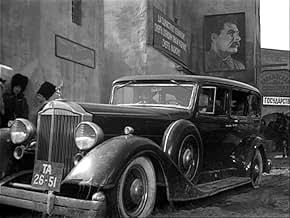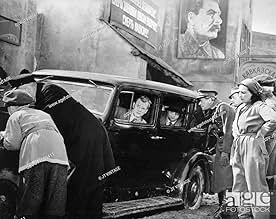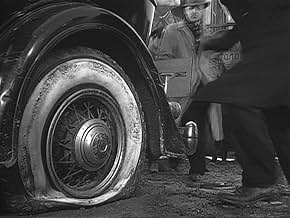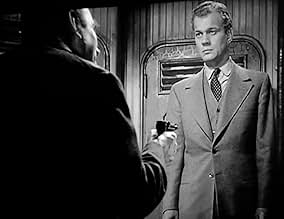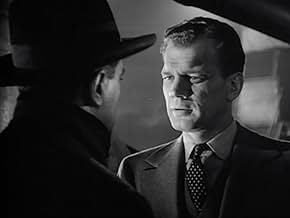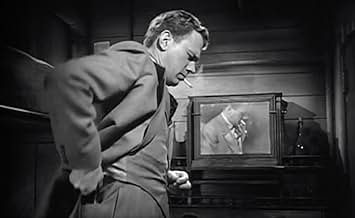IMDb रेटिंग
6.5/10
5 हज़ार
आपकी रेटिंग
अपनी भाषा में प्लॉट जोड़ेंAn American ballistics expert in Turkey finds himself targeted by German agents. Safe passage home by ship is arranged for him, but he soon discovers that his pursuers are also on board.An American ballistics expert in Turkey finds himself targeted by German agents. Safe passage home by ship is arranged for him, but he soon discovers that his pursuers are also on board.An American ballistics expert in Turkey finds himself targeted by German agents. Safe passage home by ship is arranged for him, but he soon discovers that his pursuers are also on board.
Dolores Del Río
- Josette Martel
- (as Dolores Del Rio)
Anna De Linsky
- Russian Maid at Batumi Hotel
- (बिना क्रेडिट के)
Jerome de Nuccio
- Turkish Officer
- (बिना क्रेडिट के)
Herbert Drake
- Ship's Steward
- (बिना क्रेडिट के)
फ़ीचर्ड समीक्षाएं
Orson Welles graciously denied having any directing role in Norman Foster's 'Journey into Fear (1943),' though his influence appears to be all over it. 'Citizen Kane (1941)' first showcased Welles' fondness for filming people via low and high-angled cameras, a stylistic technique that distorts statures, placing the audience in a position either of power or helplessness. Here, the talented Karl Struss who also worked on such films as 'Sunrise: A Song of Two Humans (1927)' and 'Dr. Jekyll and Mr. Hyde (1931)' employs similar techniques, capturing human faces with a threatening immediacy that distorts their features and suggests imminent danger. You won't, of course, fail to notice that the film's cast also boasts more than a few Welles regulars, mostly members of his Mercury Theatre team Joseph Cotten, Agnes Moorehead, Everett Sloane, Ruth Warrick and Welles himself. The film's screenplay was written by Cotten, his sole attempt at writing {outside some uncredited work on 'The Magnificent Ambersons (1942)'}, a pity since the dialogue is frequently crisp, intelligent and memorable.
'Journey into Fear' is one of those rare WWII-themed films of the early 1940s that you wouldn't automatically class as propaganda. Indeed, the Nazis are only mentioned in passing, and the sinister agents who attempt to assassinate Cotten could just as easily be motivated by reasons other than war. Much of the story takes place on a small passenger ship, on which American engineer Howard Graham (Cotten) seeks refuge from German assassins, who are hell-bent on delaying his return home with important Allied intelligence. Silent enemy Peter Banat (played by Welles' agent, Jack Moss) watches ominously from across the ship's cabin, never saying a word, but suggesting sadistic menace through every dryly-amused smirk. Cotten is strong in the lead role, playing Graham as a frightened and confused amateur, a role reminiscent of Holly Martins from 'The Third Man (1949),' rather than the experienced and resourceful American spy we would otherwise expect in such a film. Welles lends his mighty presence to the role of the Turkish Colonel Haki, though he is noticeably more subdued than usual.
In one final manner, 'Journey into Evil' is very much like an Orson Welles film: it was re-edited at the studio's request. According to some sources, Welles did some of the trimming himself, recutting the final reel and adding Joseph Cotten's rather awkward narration. At just 68 minutes in length, the film certainly feels as though it has been tampered with. The relationship between Graham and Rosette (Dolores del Rio) is brief and poorly explored, and certainly not worthy of the repeated reassurances that the former frequently bestows upon his anxious wife (Ruth Warrick); there's little indication that the their affiliation extended beyond exchanging a few harmless pleasantries. Though the film doesn't exactly feel incomplete as did a noir like Renoir's 'The Woman on the Beach (1947)' the bare-bones narrative gives the sense of a minor and inconsequential work. Even so, 'Journey into Evil' is well worth seeking out for its terrific photography including a superb climax on the slippery ledges of a hotel exterior and the talents of a very talented cast.
'Journey into Fear' is one of those rare WWII-themed films of the early 1940s that you wouldn't automatically class as propaganda. Indeed, the Nazis are only mentioned in passing, and the sinister agents who attempt to assassinate Cotten could just as easily be motivated by reasons other than war. Much of the story takes place on a small passenger ship, on which American engineer Howard Graham (Cotten) seeks refuge from German assassins, who are hell-bent on delaying his return home with important Allied intelligence. Silent enemy Peter Banat (played by Welles' agent, Jack Moss) watches ominously from across the ship's cabin, never saying a word, but suggesting sadistic menace through every dryly-amused smirk. Cotten is strong in the lead role, playing Graham as a frightened and confused amateur, a role reminiscent of Holly Martins from 'The Third Man (1949),' rather than the experienced and resourceful American spy we would otherwise expect in such a film. Welles lends his mighty presence to the role of the Turkish Colonel Haki, though he is noticeably more subdued than usual.
In one final manner, 'Journey into Evil' is very much like an Orson Welles film: it was re-edited at the studio's request. According to some sources, Welles did some of the trimming himself, recutting the final reel and adding Joseph Cotten's rather awkward narration. At just 68 minutes in length, the film certainly feels as though it has been tampered with. The relationship between Graham and Rosette (Dolores del Rio) is brief and poorly explored, and certainly not worthy of the repeated reassurances that the former frequently bestows upon his anxious wife (Ruth Warrick); there's little indication that the their affiliation extended beyond exchanging a few harmless pleasantries. Though the film doesn't exactly feel incomplete as did a noir like Renoir's 'The Woman on the Beach (1947)' the bare-bones narrative gives the sense of a minor and inconsequential work. Even so, 'Journey into Evil' is well worth seeking out for its terrific photography including a superb climax on the slippery ledges of a hotel exterior and the talents of a very talented cast.
Somewhere along the way, someone took scissors to this film and left it with plot holes that don't connect. Despite the obvious flaws in continuity and plotting, Eric Ambler's novel has been so changed in transferring it to the screen that he didn't even recognize it as his own story, according to Robert Osborne of TCM.
The marquee value of Joseph Cotten and Orson Welles is likely to lure viewers into thinking they will see another classic along the lines of THE THIRD MAN. Not so. This is a visually interesting espionage yarn, very little of which is coherent and much of which leaves the viewer in as much confusion as Joseph Cotten's character is. Whom should he trust and who is really trying to kill him?
Cotten plays a U.S. Naval engineer aboard a dilapidated freighter who learns that Nazi agents are planning to kill him. The usual Welles Mercury Theater players fill the supporting roles, along with the beautiful Dolores Del Rio. Once the film leaves the claustrophobic freighter and shows Cotten running from his captors, it takes on heightened interest. The scenes in the torrential rain are wonderfully staged and the B&W cinematography gives the illusion of menace in every shadow.
But there is virtually no coherent plot and Welles is completely wasted in a small role that he underplays. While the credits say that Norman Foster directed, it is highly probable that Welles himself directed much of it. Perhaps it all made more sense before the running time was cut down to 71 minutes.
Ruth Warrick has a couple of nice moments as Cotten's patient wife but none of the characters are fleshed out enough to really understand or care about. Cotten gives his usual workmanlike performance but it all ends with a rather abrupt finish, much ado about nothing.
Too many weaknesses to call a classic.
The marquee value of Joseph Cotten and Orson Welles is likely to lure viewers into thinking they will see another classic along the lines of THE THIRD MAN. Not so. This is a visually interesting espionage yarn, very little of which is coherent and much of which leaves the viewer in as much confusion as Joseph Cotten's character is. Whom should he trust and who is really trying to kill him?
Cotten plays a U.S. Naval engineer aboard a dilapidated freighter who learns that Nazi agents are planning to kill him. The usual Welles Mercury Theater players fill the supporting roles, along with the beautiful Dolores Del Rio. Once the film leaves the claustrophobic freighter and shows Cotten running from his captors, it takes on heightened interest. The scenes in the torrential rain are wonderfully staged and the B&W cinematography gives the illusion of menace in every shadow.
But there is virtually no coherent plot and Welles is completely wasted in a small role that he underplays. While the credits say that Norman Foster directed, it is highly probable that Welles himself directed much of it. Perhaps it all made more sense before the running time was cut down to 71 minutes.
Ruth Warrick has a couple of nice moments as Cotten's patient wife but none of the characters are fleshed out enough to really understand or care about. Cotten gives his usual workmanlike performance but it all ends with a rather abrupt finish, much ado about nothing.
Too many weaknesses to call a classic.
`Journey Into Fear' certainly has an Orson Welles look. Although he received neither directing nor writing credit (credit went to Norman Foster and Joseph Cotten, respectively), I think that most of what is there is his. The problem is that there is not enough there there. The on-board relationships should have been developed more. All of them seem perfunctory.
Combining the shooting by a good marksman who misses his target and stalking him in the nightclub are combined into an altogether more satisfying single event.The escape from the Nazis is more protracted and less violent than in Eric Ambler's book. It is very noirish and photogenic, and the combination of wet chase and the presence of a murky character played by Orson Welles and an all-American one played by Joseph Cotten prefigure `The Third Man.' Joseph Cotten had some of the same American innocence and ready outrage in both films. He's an important munitions engineer here and a hack western writing there. He doesn't get the dark beauty (Alida Valli or Dolores del Rio) in either, though he has and keeps a wife in `Journey.'
The film probably makes sense to those unfamiliar with the book (and such viewers aren't distracted by thinking about what's been changed). It is suspenseful even for someone like me who recently read the book
Combining the shooting by a good marksman who misses his target and stalking him in the nightclub are combined into an altogether more satisfying single event.The escape from the Nazis is more protracted and less violent than in Eric Ambler's book. It is very noirish and photogenic, and the combination of wet chase and the presence of a murky character played by Orson Welles and an all-American one played by Joseph Cotten prefigure `The Third Man.' Joseph Cotten had some of the same American innocence and ready outrage in both films. He's an important munitions engineer here and a hack western writing there. He doesn't get the dark beauty (Alida Valli or Dolores del Rio) in either, though he has and keeps a wife in `Journey.'
The film probably makes sense to those unfamiliar with the book (and such viewers aren't distracted by thinking about what's been changed). It is suspenseful even for someone like me who recently read the book
The operatic approach of adding a musical dimension to menace with a killer-theme on the soundtrack has been greatly used in Orson Welles' glorious suspense film, "Journey Into Fear," where the little killer obsessively played a scratchy old 78 rpm disc of someone singing "Chagrin d'Amour."
The assassin was short and fat; his belly large, his chin and neck flabby... I do not recall him having a line of dialog to speak But the whole film was spread with heightened menace when he sat, his little round eyes blank behind his little round pebble lenses, listening compulsively to the atrociously scratchy record, confusing the words of the song at the wrong speed, the needle jumping from groove to groove; his nerve-ends, unlike ours, immune to the discordance
This was a spy thriller set in the wartime Near East, about an innocent American engineer (Joseph Cotten), pursued by Nazi agents and blundering from danger to danger without seeming to know too much of what it was all about It was essentially a hunter-and-hunted story, with settings that were often seedy but always exotic
The opening was in Istanbul, the climax in Batum, and all the terrors between were forced claustrophobically between the low ceilings and narrow partitions of a neglected little steamer plowing the Black Sea
"Journey Into Fear" lives for its portrait gallery, its atmosphere, and for Welles' touches and excesses
The assassin was short and fat; his belly large, his chin and neck flabby... I do not recall him having a line of dialog to speak But the whole film was spread with heightened menace when he sat, his little round eyes blank behind his little round pebble lenses, listening compulsively to the atrociously scratchy record, confusing the words of the song at the wrong speed, the needle jumping from groove to groove; his nerve-ends, unlike ours, immune to the discordance
This was a spy thriller set in the wartime Near East, about an innocent American engineer (Joseph Cotten), pursued by Nazi agents and blundering from danger to danger without seeming to know too much of what it was all about It was essentially a hunter-and-hunted story, with settings that were often seedy but always exotic
The opening was in Istanbul, the climax in Batum, and all the terrors between were forced claustrophobically between the low ceilings and narrow partitions of a neglected little steamer plowing the Black Sea
"Journey Into Fear" lives for its portrait gallery, its atmosphere, and for Welles' touches and excesses
Howard Graham is an American engineer returning from Istanbul with his wife Stephanie. A close call in a Turkish nightclub sees a man assassinated by mistake when really Howard was the target and he and his wife are quickly taken to the Turkish secret police. Colonel Haki informs him that he is a target of the Nazis and immediately gets him transit out of the country on the next available boat while he protects his wife. However Howard quickly finds that he is far from being out of danger as his pursuers are on the boat as well.
With keys part of the Third Man cast involved in this thriller, I decided to take a look and had hoped for a film that perhaps would be as enjoyable as that. However it was not quite all that I hoped it would have been as I didn't find myself that gripped by it. The early scenes suggest a real mystery with a good pace but quickly the mistaken assassination of the magician is slowed down and complicated by unnecessary characters and dialogue, some of which seemed to serve very little purpose other than setting up some other scenes later on. With Mrs Howard away somewhere out of vision and therefore out of mind, we focus on the action on other boat and, although quite tense at points, it didn't have the sort of sustained tension that should have been made easier by the confined location of the boat. It does enough to engage though and I did find it quite enjoyable but those claiming this as a classic up there with some of Welles' other films are mistaken because this is only quite good not any more than that.
The cast was the reason I was here but they were not as good as they have been in other films. Cotton is a bit brash and loud and aspects of his character aren't brought out that well; he was still an interesting leading man but mainly because I have always liked him. Welles has a small role and seems to enjoy himself playing a role that has little screen time but is mentioned throughout the film; I'm not sure if he did direct his own scenes but that is the rumour. Del Rio is sexy and a nice presence but I wasn't overly taken by her other than that. Moss tends to steal the film with his big character lurking around early on, meanwhile the rest of the support are OK, with other languages being spoken rather than the usual American actors putting on vague accents as was often the case (and still is!). Assuming that he did direct the majority, if not all, of the film (and I do believe this) Foster does a very good job of working with shadows in early scenes and in the boat some of his angles are effective, although it is easy to see (with some of his shots) why people generally believe that it was Welles calling the shots.
Overall this is an enjoyable thriller with a dark atmosphere brought out by good direction throughout. The cast are OK but none of the famous faces really stood out for me here, meanwhile the plot was not as tight as it needed to be, leaving some holes and using some distracting plot devices along the way. Still worth seeing but not the classic that it is often touted around as being.
With keys part of the Third Man cast involved in this thriller, I decided to take a look and had hoped for a film that perhaps would be as enjoyable as that. However it was not quite all that I hoped it would have been as I didn't find myself that gripped by it. The early scenes suggest a real mystery with a good pace but quickly the mistaken assassination of the magician is slowed down and complicated by unnecessary characters and dialogue, some of which seemed to serve very little purpose other than setting up some other scenes later on. With Mrs Howard away somewhere out of vision and therefore out of mind, we focus on the action on other boat and, although quite tense at points, it didn't have the sort of sustained tension that should have been made easier by the confined location of the boat. It does enough to engage though and I did find it quite enjoyable but those claiming this as a classic up there with some of Welles' other films are mistaken because this is only quite good not any more than that.
The cast was the reason I was here but they were not as good as they have been in other films. Cotton is a bit brash and loud and aspects of his character aren't brought out that well; he was still an interesting leading man but mainly because I have always liked him. Welles has a small role and seems to enjoy himself playing a role that has little screen time but is mentioned throughout the film; I'm not sure if he did direct his own scenes but that is the rumour. Del Rio is sexy and a nice presence but I wasn't overly taken by her other than that. Moss tends to steal the film with his big character lurking around early on, meanwhile the rest of the support are OK, with other languages being spoken rather than the usual American actors putting on vague accents as was often the case (and still is!). Assuming that he did direct the majority, if not all, of the film (and I do believe this) Foster does a very good job of working with shadows in early scenes and in the boat some of his angles are effective, although it is easy to see (with some of his shots) why people generally believe that it was Welles calling the shots.
Overall this is an enjoyable thriller with a dark atmosphere brought out by good direction throughout. The cast are OK but none of the famous faces really stood out for me here, meanwhile the plot was not as tight as it needed to be, leaving some holes and using some distracting plot devices along the way. Still worth seeing but not the classic that it is often touted around as being.
क्या आपको पता है
- ट्रिवियाThe great stage actor Richard Bennett had been brought back to films by Orson Welles for The Magnificent Ambersons (1942). Although his performance as old Major Amberson has become legendary, it was achieved with great difficulty, as Bennett, by then an old man near death, found it hard to remember his lines, and his eyesight was too poor for him to be able to read cue-cards. Welles's patience in dealing with these problems has been widely described. When he cast Bennett as the ship's captain, he overcame the problems simply by giving Bennett no dialogue at all, although the character has several memorable scenes. It was Bennett's final film role.
- गूफ़During the chase outside the hotel in the rain, Banat's pistol, a P-08 "Luger" runs out of ammunition, but the action closes normally after he fires the last shot. This particular pistol was designed so that the action stays open after the last round is fired, giving a clear indication to the user that the gun is empty.
- भाव
Colonel Haki: Ah, you have this advantage over the soldier, Mr. Graham. You can run away without being a coward.
- इसके अलावा अन्य वर्जनIn 2005 an alternate cut was shown at the Orson Welles film retrospective in Locarno, Switzerland. It was the original European release print, lacking the narration and ending of the US version but including about eight minutes of footage later deleted by RKO, reportedly for political and censorship reasons. This alternate version, assembled by Stefan Droessler of the Münchner Filmmuseum, was shown at the Museum of Modern Art on Saturday, November 21, 2015.
- कनेक्शनFeatured in Terminus... the Theater of Science Fiction: Journey into Fear (1970)
- साउंडट्रैकC'est mon coeur
(uncredited)
Written by Steven Morgan
टॉप पसंद
रेटिंग देने के लिए साइन-इन करें और वैयक्तिकृत सुझावों के लिए वॉचलिस्ट करें
- How long is Journey Into Fear?Alexa द्वारा संचालित
विवरण
- चलने की अवधि
- 1 घं 8 मि(68 min)
- रंग
- पक्ष अनुपात
- 1.37 : 1
इस पेज में योगदान दें
किसी बदलाव का सुझाव दें या अनुपलब्ध कॉन्टेंट जोड़ें

